Java Socket编程实例:http://donald-draper.iteye.com/blog/2356695
java Socket读写缓存区Writer和Reader:http://donald-draper.iteye.com/blog/2356885
前一篇文章中,我们讲了java Socket io的Writer和Reader,在上一篇中,在流解码器和
编码器中,经常用到字节缓冲ByteBuffer,今天我们就来看一ByteBuffer。
ByteBuffer有两个实现一个为,HeapByteBuffer,另一个为DirectByteBuffer,这两个有什么区别呢?
我们引入原文,不翻译以免都是原味;
1.HeapByteBuffer
class="java" name="code">//ByteBuffer,创建方法
public static ByteBuffer allocate(int capacity) {
if (capacity < 0)
throw new IllegalArgumentException();
return new HeapByteBuffer(capacity, capacity);
}
HeapByteBuffer使用的java堆
内存
2.DirectByteBuffer
//ByteBuffer,创建方法
public static ByteBuffer allocateDirect(int capacity) {
return new DirectByteBuffer(capacity);
}
* <p> A byte buffer is either <i>direct</i> or <i>non-direct</i>. Given a
* direct byte buffer, the Java virtual machine will make a best effort to
* perform native I/O operations directly upon it. That is, it will attempt to
* avoid copying the buffer's content to (or from) an intermediate buffer
* before (or after) each invocation of one of the underlying operating
* system's native I/O operations.
*
* <p> A direct byte buffer may be created by invoking the {@link
* #allocateDirect(int) allocateDirect} factory method of this class. The
* buffers returned by this method typically have somewhat higher allocation
* and deallocation costs than non-direct buffers. The contents of direct
* buffers may reside outside of the normal garbage-collected heap, and so
* their impact upon the memory footprint of an application might not be
* obvious. It is therefore recommended that direct buffers be allocated
* primarily for large, long-lived buffers that are subject to the underlying
* system's native I/O operations. In general it is best to allocate direct
* buffers only when they yield a measureable gain in program performance.
*
* <p> A direct byte buffer may also be created by {@link
* java.nio.channels.FileChannel#map </code>mapping<code>} a region of a file
* directly into memory. An implementation of the Java platform may optionally
* support the creation of direct byte buffers from native code via JNI. If an
* instance of one of these kinds of buffers refers to an inaccessible region
* of memory then an attempt to access that region will not change the buffer's
* content and will cause an unspecified exception to be thrown either at the
* time of the access or at some later time.
DirectByteBuffer使用的是:the Java virtual machine will make a best effort to
perform native I/O operations directly upon it.
使用时要注意:It is therefore recommended that direct buffers be allocated
primarily for large, long-lived buffers that are subject to the underlying
system's native I/O operations
今天我们只讲HeapByteBuffer,ByteBuffer,Buffer,我们先从测试实例来看
public abstract class Buffer {
// Invariants: mark <= position <= limit <= capacity
private int mark = -1;//标记,用于reset函数,是复位position到mark位置
private int position = 0;//Buffer缓冲区读写位置
private int limit;//读写上限
private int capacity;//缓冲区容量
}
mark,position,limit,capacity大小关系:
-1 <= mark <= position <= limit <= capacity;
0<= position <= limit <= capacity;
测试主类:
package socket;
import java.nio.BufferOverflowException;
import java.nio.ByteBuffer;
/**
* 测试ByteBuffer
* @author donald
* 2017年2月14日
* 下午5:23:32
*/
public class TestByteBuffer {
private static ByteBuffer byteBuffer = null;
public static void main(String[] args) {
/* 以下顺序不要改变*/
initByteBuffer();
testByte();
testChar();
testMark();
testInt();
testFloat();
testDouble();
testLong();
testRemaining();
testOverFlow();
testReset();
testClear();
// testCompact();
}
/**
* 初始化缓存空间
*/
public static void initByteBuffer(){
byteBuffer = ByteBuffer.allocate(32);
System.out.println("===============init status============");
System.out.println("position:"+byteBuffer.position());
System.out.println("limit:"+byteBuffer.limit());
System.out.println("capacity:"+byteBuffer.capacity());
}
/**
* 测试Byte,占用一个字节
*/
public static void testByte(){
System.out.println("===============put byte============");
//字节
byte bbyte = 102;
byteBuffer.put(bbyte);//ByteBuffer
byteBuffer.get(0);//byte
System.out.println("position:"+byteBuffer.position());
System.out.println("limit:"+byteBuffer.limit());
System.out.println("capacity:"+byteBuffer.capacity());
System.out.println("======get byte:"+byteBuffer.get(0));
}
/**
* 测试Char,占用2个字节
*/
public static void testChar(){
System.out.println("===============put char============");
//字符
char aChar= 'a';
byteBuffer.putChar(aChar);
System.out.println("position:"+byteBuffer.position());
System.out.println("limit:"+byteBuffer.limit());
System.out.println("capacity:"+byteBuffer.capacity());
System.out.println("======get Char:"+byteBuffer.getChar(1));
}
/**
* 标记位置,以便reset,返回这个标记位置
*/
public static void testMark(){
//标记位置
byteBuffer.mark();
System.out.println("===============mark============");
System.out.println("position:"+byteBuffer.position());
System.out.println("limit:"+byteBuffer.limit());
System.out.println("capacity:"+byteBuffer.capacity());
}
/**
* 测试int,占用4个字节
*/
public static void testInt(){
System.out.println("===============put int============");
//int
int int4 = 4;
byteBuffer.putInt(int4);
System.out.println("position:"+byteBuffer.position());
System.out.println("limit:"+byteBuffer.limit());
System.out.println("capacity:"+byteBuffer.capacity());
//这里为什么从第三个字节开始读取,因为前面一个字节和一个字符总共三个字节
System.out.println("======get int:"+byteBuffer.getInt(3));
}
/**
* 测试float,占用4个字节
*/
public static void testFloat(){
System.out.println("===============put float============");
//float
float float5 = 10;
byteBuffer.putFloat(float5);
System.out.println("position:"+byteBuffer.position());
System.out.println("limit:"+byteBuffer.limit());
System.out.println("capacity:"+byteBuffer.capacity());
//这里为什么从第7个字节开始读取,因为前面一个字节和一个字符,一个int总共7个字节
System.out.println("======get float:"+byteBuffer.getFloat(7));
}
/**
* 测试double,占用8个字节
*/
public static void testDouble(){
System.out.println("===============put double============");
//double
double double6 = 20.0;
byteBuffer.putDouble(double6);
System.out.println("position:"+byteBuffer.position());
System.out.println("limit:"+byteBuffer.limit());
System.out.println("capacity:"+byteBuffer.capacity());
//这里为什么从第11个字节开始读取,因为前面一个字节和一个字符,一个int,一个float总共11个字节
System.out.println("======get double:"+byteBuffer.getDouble(11));
}
/**
* 测试Long,占用8个字节
*/
public static void testLong(){
System.out.println("===============put long============");
//long
long long7 = (long) 30.0;
byteBuffer.putLong(long7);
System.out.println("position:"+byteBuffer.position());
System.out.println("limit:"+byteBuffer.limit());
System.out.println("capacity:"+byteBuffer.capacity());
//这里为什么从第19个字节开始读取,因为前面一个字节和一个字符,一个int,一个float,一个double总共19个字节
System.out.println("======get long:"+byteBuffer.getLong(19));
}
/**
* 测试字节缓冲的剩余空间函数
*/
public static void testRemaining(){
System.out.println("======buffer 剩余空间大小:"+byteBuffer.remaining());
}
/**
* 测试添加元素字节长度,大于剩余空间时的情况
*/
public static void testOverFlow(){
/*Exception in thread "main" java.nio.BufferOverflowException
at java.nio.Buffer.nextPutIndex(Buffer.java:519)
at java.nio.HeapByteBuffer.putLong(HeapByteBuffer.java:417)
at socket.TestByteBuffer.main(TestByteBuffer.java:60)
超出空间,则抛出BufferOverflowException异常
*/
try{
byteBuffer.putLong((long)30.0);
}
catch(BufferOverflowException e){
e.printStackTrace();
}
}
/**
* 测试回到标记,position为标记的mark
*/
public static void testReset(){
System.out.println("===============reset============");
//回到mark标记位置,position为标记的mark
byteBuffer.reset();
System.out.println("position:"+byteBuffer.position());
System.out.println("limit:"+byteBuffer.limit());
System.out.println("capacity:"+byteBuffer.capacity());
System.out.println("======get int from mark:"+byteBuffer.getInt(3));
//重新,从标记位置put一个int值,原来的内容被覆盖掉
int int5 = 5;
byteBuffer.putInt(int5);
System.out.println("position:"+byteBuffer.position());
System.out.println("limit:"+byteBuffer.limit());
System.out.println("capacity:"+byteBuffer.capacity());
System.out.println("======get int from mark after put new int value:"+byteBuffer.getInt(3));
}
/**
* clear重置position,mark,limit位置,原始缓存区内容并不清掉
*/
public static void testClear(){
System.out.println("===============clear============");
//clear重置position,mark,limit位置,原始缓存区内容并不清掉
byteBuffer.clear();
System.out.println("position:"+byteBuffer.position());
System.out.println("limit:"+byteBuffer.limit());
System.out.println("capacity:"+byteBuffer.capacity());
System.out.println("======get int after clear:"+byteBuffer.getInt(3));
}
public static void testCompact(){
System.out.println("===============compact============");
/*
* compact操作用于当
* while (in.read(buf) >= 0 || buf.position != 0) {
* buf.flip();
* out.write(buf);
* buf.compact(); // In case of partial write
* }
* 当out发送数据,即读取buf的数据,write方法可能只发送了部分数据,buf里还有剩余,
* 这时调用buf.compact()函数将position与limit之间的数据,copy到buf的0到limit-position,进行压缩(非实际以压缩,只是移动),
* 以便下次 向写入缓存。
*/
byteBuffer.compact();
System.out.println("position:"+byteBuffer.position());
System.out.println("limit:"+byteBuffer.limit());
System.out.println("capacity:"+byteBuffer.capacity());
System.out.println("======get int:"+byteBuffer.getInt(3));
System.out.println("===============flip============");
/*
* buf.put(magic); // Prepend header
* in.read(buf); // Read data into rest of buffer
* buf.flip(); // Flip buffer
* out.write(buf);
* 当in从缓冲中读取数据后,如果想要将缓存中的数据发送出去,则调用buf.flip()函数,limit为当前position,position为0,
* /
// byteBuffer.flip();
System.out.println("===============rewind============");
/*
* out.write(buf); // Write remaining data
* buf.rewind(); // Rewind buffer
* buf.get(array); // Copy data into array</pre></blockquote>
* 当out写出数据,即读取buf的数据后,如果想要从缓存中,从0位置,获取缓存数据,则调用buf.rewind()
*/
// byteBuffer.rewind();
}
}
注意 main里面方法的调用顺序不要变,第一次测试我们先
注释掉testCompact方法,控制台输出:
===============init status============
position:0
limit:32
capacity:32
===============put byte============
position:1
limit:32
capacity:32
======get byte:102
===============put char============
position:3
limit:32
capacity:32
======get Char:a
===============mark============
position:3
limit:32
capacity:32
===============put int============
position:7
limit:32
capacity:32
======get int:4
===============put float============
position:11
limit:32
capacity:32
======get float:10.0
===============put double============
position:19
limit:32
capacity:32
======get double:20.0
===============put long============
position:27
limit:32
capacity:32
======get long:30
======buffer 剩余空间大小:5
java.nio.BufferOverflowException
at java.nio.Buffer.nextPutIndex(Buffer.java:519)
at java.nio.HeapByteBuffer.putLong(HeapByteBuffer.java:417)
at socket.TestByteBuffer.testOverFlow(TestByteBuffer.java:150)
at socket.TestByteBuffer.main(TestByteBuffer.java:24)
===============reset============
position:3
limit:32
capacity:32
======get int from mark:4
position:7
limit:32
capacity:32
======get int from mark after put new int value:5
===============clear============
position:0
limit:32
capacity:32
======get int after clear:5
从控制台输出可看出,ByteBuffer的put*和get*(int index)方法不改变mark,limit和capacity的值;put则回改变position的位置,put操作后position的位置为,put操作之前position+length(put 操作数);mark操作会改变mark的值,reset操作,则是将position定位到mark;clear操作并不会清空缓冲空间,而是将position复位0,limit为capacity,mark为-1;remain操作返回的是可用的空间大小为capacity-position;
如put后,超出缓冲区大小,则抛出BufferOverflowException异常。
下面我们将mark,reset和clear注释掉,测试Compact操作如下:
public static void main(String[] args) {
/* 以下顺序不要改变*/
initByteBuffer();
testByte();
testChar();
// testMark();
testInt();
testFloat();
testDouble();
testLong();
testRemaining();
testOverFlow();
// testReset();
// testClear();
testCompact();
}
关注控制的compact部分输出:
===============put long============
position:27
limit:32
capacity:32
======get long:30
======buffer 剩余空间大小:5
java.nio.BufferOverflowException
at java.nio.Buffer.nextPutIndex(Buffer.java:519)
at java.nio.HeapByteBuffer.putLong(HeapByteBuffer.java:417)
at socket.TestByteBuffer.testOverFlow(TestByteBuffer.java:150)
at socket.TestByteBuffer.main(TestByteBuffer.java:24)
===============compact============
position:5
limit:32
capacity:32
======get int:4
===============flip============
===============rewind============
从控制台输出可以看出,compact操作一般在一下情况调用,
/*
* compact操作用于当
* while (in.read(buf) >= 0 || buf.position != 0) {
* buf.flip();
* out.write(buf);
* buf.compact(); // In case of partial write
* }
*/
当out发送数据,即读取buf的数据,write方法可能只发送了部分数据,buf里还有剩余,
这时调用buf.compact()函数将position与limit之间的数据,copy到buf的0到limit-position,
进行压缩(非实际以压缩,只是移动),以便下次 向写入缓存。当position与limit之间的数据为空时,则不改变原缓冲区,否则copy相应数据。
//HeapByteBuffer
public ByteBuffer compact() {
System.arraycopy(hb, ix(position()), hb, ix(0), remaining());
position(remaining());
limit(capacity());
discardMark();
return this;
}
/*
If <code>src</code> is <code>null</code>, then a
* <code>NullPointerException</code> is thrown and the destination
* array is not modified.
*/
//System
public static native void arraycopy(Object src, int srcPos,
Object dest, int destPos,
int length);
线面我们来看一下Buffer的相关操作:
public abstract class Buffer {
// Invariants: mark <= position <= limit <= capacity
private int mark = -1;
private int position = 0;
private int limit;
private int capacity;
//返回position
public final int position() {
return position;
}
//返回capacity
public final int capacity() {
return capacity;
}
//重新定义position位置,如mark位置大于新position,则废弃mark位置
public final Buffer position(int newPosition) {
if ((newPosition > limit) || (newPosition < 0))
throw new IllegalArgumentException();
position = newPosition;
if (mark > position) mark = -1;
return this;
}
//返回limit
public final int limit() {
return limit;
}
//标记位置
public final Buffer mark() {
mark = position;
return this;
}
//复位position到mark位置
public final Buffer reset() {
int m = mark;
if (m < 0)
throw new InvalidMarkException();
position = m;
return this;
}
//clear操作并不会清空缓冲空间,而是将
//position复位0,limit为capacity,mark为-1;
public final Buffer clear() {
position = 0;
limit = capacity;
mark = -1;
return this;
}
/*
* buf.put(magic); // Prepend header
* in.read(buf); // Read data into rest of buffer
* buf.flip(); // Flip buffer
* out.write(buf);
* 当in从缓冲中读取数据后,如果想要将缓存中的数据发送出去,
* 则调用buf.flip()函数,limit为当前position,position为0,
*/
public final Buffer flip() {
limit = position;
position = 0;
mark = -1;
return this;
}
/*
* out.write(buf); // Write remaining data
* buf.rewind(); // Rewind buffer
* buf.get(array); // Copy data into array</pre></blockquote>
* 当out写出数据,即读取buf的数据后,如果想要从缓存中,从0位置,获取缓存数据,则调用buf.rewind()
*/
public final Buffer rewind() {
position = 0;
mark = -1;
return this;
}
//返回可用空间
public final int remaining() {
return limit - position;
}
//废弃标记位置
final void discardMark() { // package-private
mark = -1;
}
Buffer(int mark, int pos, int lim, int cap) { // package-private
if (cap < 0)
throw new IllegalArgumentException("Negative capacity: " + cap);
this.capacity = cap;
limit(lim);
position(pos);
if (mark >= 0) {
if (mark > pos)
throw new IllegalArgumentException("mark > position: ("
+ mark + " > " + pos + ")");
this.mark = mark;
}
}
}
再来看ByteBuffer
public abstract class ByteBuffer
extends Buffer
implements Comparable<ByteBuffer>
{
// These fields are declared here rather than in Heap-X-Buffer in order to
// reduce the number of virtual method invocations needed to access these
// values, which is especially costly when coding small buffers.
//
final byte[] hb; // Non-null only for heap buffers,缓存空间
final int offset;
boolean isReadOnly;
ByteBuffer(int mark, int pos, int lim, int cap, // package-private
byte[] hb, int offset)
{
super(mark, pos, lim, cap);
this.hb = hb;
this.offset = offset;
}
}
再来看
class HeapByteBuffer
extends ByteBuffer
{
HeapByteBuffer(byte[] buf, int off, int len) { // package-private
super(-1, off, off + len, buf.length, buf, 0);
/*
hb = buf;
offset = 0;
*/
}
}
来看压缩函数
/*
* compact操作用于当
* while (in.read(buf) >= 0 || buf.position != 0) {
* buf.flip();
* out.write(buf);
* buf.compact(); // In case of partial write
* }
* 当out发送数据,即读取buf的数据,write方法可能只发送了部分数据,buf里还有剩余,
* 这时调用buf.compact()函数将position与limit之间的数据,copy到buf的0到limit-position,
* 进行压缩(非实际以压缩,只是移动),
* 以便下次 向写入缓存。
*/
public ByteBuffer compact() {
//将position与limit之间的数据,copy到buf的0到limit-position
System.arraycopy(hb, ix(position()), hb, ix(0), remaining());
//重新定位position
position(remaining());
//重新赋值limit
limit(capacity());
//废弃标记位置
discardMark();
return this;
}
在来看一下put函数
public ByteBuffer putChar(char x) {
//Char,占两字节
Bits.putChar(this, ix(nextPutIndex(2)), x, bigEndian);
return this;
}
public ByteBuffer putInt(int x) {
//int占4个字节
Bits.putInt(this, ix(nextPutIndex(4)), x, bigEndian);
return this;
}
我们,详看一下putInt
//Buffer
//判断是否有足够空间存放nb个字节,并返回position的原先位置,同时移动position
final int nextPutIndex(int nb) { // package-private
if (limit - position < nb)
throw new BufferOverflowException();
int p = position;
position += nb;
return p;
}
//HeapByteBuffer
//定位到缓存写开始的位置
protected int ix(int i) {
return i + offset;
}
//Bits
将int值x,从bb的bi位置,写入
static void putInt(ByteBuffer bb, int bi, int x, boolean bigEndian) {
if (bigEndian)
putIntB(bb, bi, x);
else
putIntL(bb, bi, x);
}
//由于int占4个字节,将int的每个字节,拆分放入缓存ByteBuffer中
static void putIntL(ByteBuffer bb, int bi, int x) {
bb._put(bi + 3, int3(x));
bb._put(bi + 2, int2(x));
bb._put(bi + 1, int1(x));
bb._put(bi , int0(x));
}
private static byte int3(int x) { return (byte)(x >> 24); }
private static byte int2(int x) { return (byte)(x >> 16); }
private static byte int1(int x) { return (byte)(x >> 8); }
private static byte int0(int x) { return (byte)(x ); }
从ByteBuffer bb的比位置获取int值
static int getIntL(ByteBuffer bb, int bi) {
return makeInt(bb._get(bi + 3),
bb._get(bi + 2),
bb._get(bi + 1),
bb._get(bi ));
static private int makeInt(byte b3, byte b2, byte b1, byte b0) {
return (((b3 ) << 24) |
((b2 & 0xff) << 16) |
((b1 & 0xff) << 8) |
((b0 & 0xff) ));
}
从上面可以看出向缓存中写入占多字节的原始类型Char,int,float等时,
HeapByteBuffer,通过Bit将原始类型字节拆分存入到ByteBuffer的缓存中。
总结:
get*(int index)方法不改变mark,limit和capacity的值;put则回改变position的位置,put操作后position的位置为,put操作之前position+length(put 操作数);
mark操作会改变mark的值,reset操作,则是将position定位到mark;clear操作并不会清空缓冲空间,而是将position复位0,limit为capacity,mark为-1;remain操作返回的是可用的空间大小为capacity-position;如put后,超出缓冲区大小,则抛出BufferOverflowException异常。
compact操作一般在一下情况调用,当out发送数据,即读取buf的数据,write方法可能只发送了部分数据,buf里还有剩余,这时调用buf.compact()函数将position与limit之间的数据,copy到buf的0到limit-position,进行压缩(非实际以压缩,只是移动),以便下次 向写入缓存。当position与limit之间的数据为空时,则不改变原缓冲区,否则copy相应数据。HeapByteBuffer向缓存中写入占多字节的原始类型Char,int,float等时,HeapByteBuffer,通过Bit将原始类型字节拆分存入到ByteBuffer的缓存中。
下面用图来模仿相关操作:
初始化:

写数据:

mark:
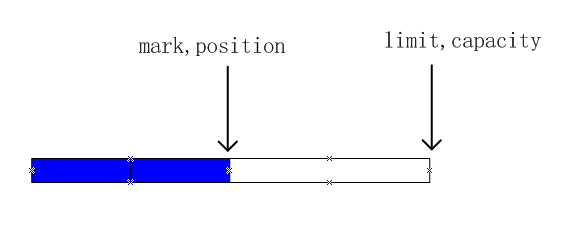
再次写数据:

reset操作:
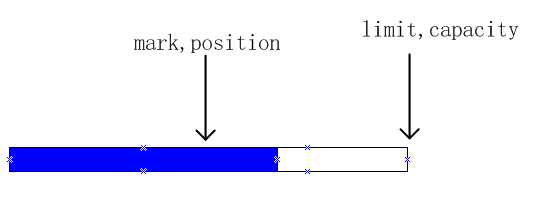
flip操作,左图为操作前,右图为操作后;

rewind操作,左图为操作前,右图为操作后;

clear操作,上图为操作前,下图为操作后;
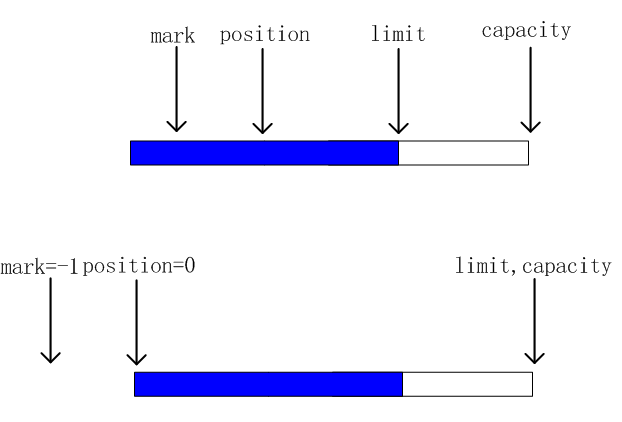
compact操作,有数据的情况下,上图为操作前,下图为操作后;
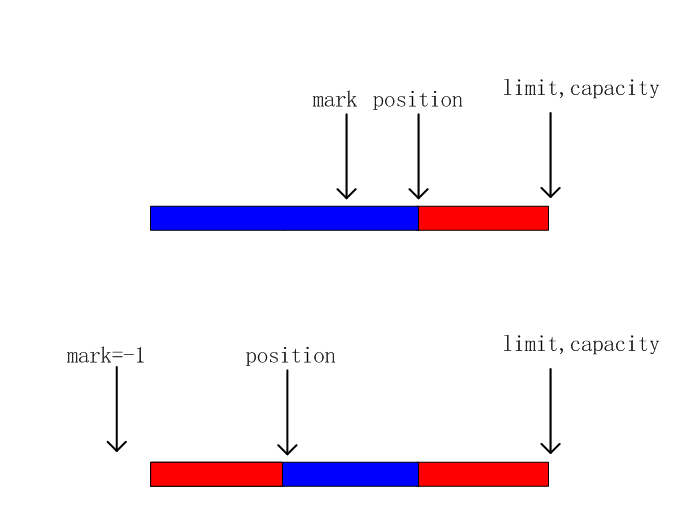
compact操作,无数据的情况下,上图为操作前,下图为操作后;
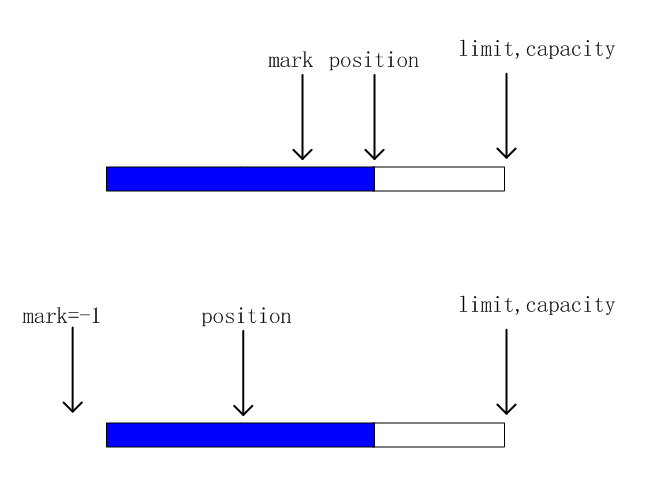
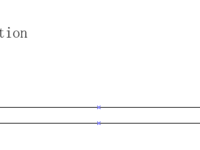
- 大小: 5.1 KB
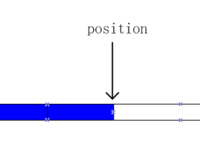
- 大小: 5.4 KB

- 大小: 5 KB
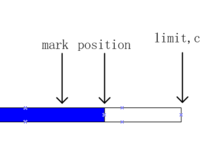
- 大小: 5 KB

- 大小: 4.6 KB
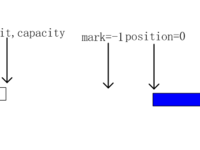
- 大小: 9.6 KB
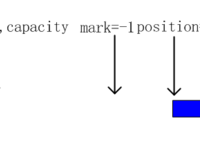
- 大小: 6.8 KB
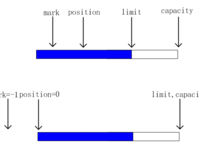
- 大小: 9.6 KB

- 大小: 10.1 KB

- 大小: 9.9 KB









